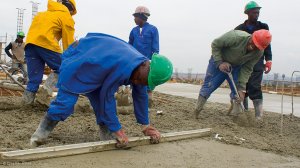SA concrete industry successful


TRAINING FOR GROWTH The Concrete Institute offers several training courses for the industry
Photo by Duane Daws
The South African concrete industry continues to be successful and is on par with international best practice in terms of large-scale projects, reports nonprofit educational organisation The Concrete Institute, based in Midrand.
The local construction of stadiums for the 2010 FIFA World Cup, the development of Gautrain infrastructure, projects that formed part of the Gauteng Freeway Improvement Project and airport upgrades, besides others, have boosted the industry to date, the institute states.
The Concrete Institute MD Bryan Perrie says South African contractors using their expertise and local materials in different scenarios helped to achieve different aspects of these builds.
He adds that start-up and small-scale construction companies lack skills in terms of basic concrete mixing methods.
Perrie says there has been an increase in queries received by The Concrete Institute, with companies seeking advice and consultations in terms of using concrete correctly.
The typical problem areas include mortars, plasters, screeds and masonry, he says. “A lot of the issues pertain to shoddy workmanship, but contractors not following proper procedures in handling concrete is also a problem,” he says, adding that part of the problem of poor workmanship is the result of a shortage of artisans.
Industry Training
The Concrete Institute offers several training courses – from entry level, which explains simple concepts, such as the basic properties of concrete, to a professional level, which tackles more complicated concepts, such as durability and the repair and quality control of concrete in all fields of application.
“A number of our courses are aimed at emerging-market builders to provide an overview of how to use concrete,” says Perrie, adding that the organisation is continually looking to partner with emerging contractors.
“We are encouraging these builders to send their personnel to attend training courses to improve their workmanship and skills.”
The Concrete Institute also provides a vast array of informative leaflets and books. “We designed some of the leaflets for semiliterate people. These leaflets depict tasks such as how to correctly mix concrete,” Perrie notes.
Most of the services offered by the organisation are free of charge, including an information and research library and advisory service, but on-site consulting and training courses carry a fee.
The Concrete Institute, which started operations in May 2013, offers concrete technology services to the construction industry and retained several key members of the previous Cement & Concrete Institute staff.
“The on-site training facility offered by the institute has been well accepted by many industry role-players,” says Perrie.
He states that with funding from cement producers AfriSam, Lafarge and Sephaku, The Concrete Institute has been able to continue offering its training programmes and other valuable services to the concrete industry.
Benefits of Concrete Roads
Perrie says the concrete industry will be supported through ongoing infrastructure projects, but notes that a potential area for growth would be roads and the use of concrete to build these roads.
The advantages of building, using and maintaining a concrete road far outweigh the benefits of asphalt roads, he tells Engineering News, adding that increasing progress is being made in the use of concrete roads in low-volume areas, such as townships, owing to the roads’ low-maintenance properties.
“Concrete roads lend themselves to labour-intensive construction and maintenance, which means that a small, low-budget team with manual tools can maintain them, compared with the conventional and costly asphalt repair team using expensive tools,” he says.
Further, light reflectance is increased in the case of concrete roads, resulting in fewer streetlights being required, vehicle headlight reach being extended further down the road and pedestrian safety being increased at night.
Light reflectance can even decrease the heat-island effect created by asphalt surfaces, which absorbs and retains heat during the day in city centres or large parking lots.
“Periods between maintenance procedures are much longer for concrete roads, compared with those of asphalt roads.
However, he notes that concrete roads are generally more expensive initially to construct, which often results in the cheaper option of building asphalt roads being favoured, which have increased maintenance costs.
The bulk of concrete roads built to date are freeways, especially the truck lanes of the N3 highway in KwaZulu-Natal, owing to concrete’s improved resistance to rutting under heavy loads.
Perrie explains that concrete roads have several uses. For instance, they can be used for slow lanes for heavy trucks, with asphalt used in the remaining lanes, which are mostly used by lighter motor vehicles. “Asphalt can be used in the construction of lanes for light motor vehicles as loading on these vehicles is negligible and will subsequently have less effect on the degradation of the surface.”
Concrete is also ideal for steep hill sections, where asphalt tends to rut as a result of slow moving trucks, and can also be used in a composite manner, where concrete forms a strong base layer under a thin layer of asphalt.
Article Enquiry
Email Article
Save Article
Feedback
To advertise email advertising@creamermedia.co.za or click here
Comments
Press Office
Announcements
What's On
Subscribe to improve your user experience...
Option 1 (equivalent of R125 a month):
Receive a weekly copy of Creamer Media's Engineering News & Mining Weekly magazine
(print copy for those in South Africa and e-magazine for those outside of South Africa)
Receive daily email newsletters
Access to full search results
Access archive of magazine back copies
Access to Projects in Progress
Access to ONE Research Report of your choice in PDF format
Option 2 (equivalent of R375 a month):
All benefits from Option 1
PLUS
Access to Creamer Media's Research Channel Africa for ALL Research Reports, in PDF format, on various industrial and mining sectors
including Electricity; Water; Energy Transition; Hydrogen; Roads, Rail and Ports; Coal; Gold; Platinum; Battery Metals; etc.
Already a subscriber?
Forgotten your password?
Receive weekly copy of Creamer Media's Engineering News & Mining Weekly magazine (print copy for those in South Africa and e-magazine for those outside of South Africa)
➕
Recieve daily email newsletters
➕
Access to full search results
➕
Access archive of magazine back copies
➕
Access to Projects in Progress
➕
Access to ONE Research Report of your choice in PDF format
RESEARCH CHANNEL AFRICA
R4500 (equivalent of R375 a month)
SUBSCRIBEAll benefits from Option 1
➕
Access to Creamer Media's Research Channel Africa for ALL Research Reports on various industrial and mining sectors, in PDF format, including on:
Electricity
➕
Water
➕
Energy Transition
➕
Hydrogen
➕
Roads, Rail and Ports
➕
Coal
➕
Gold
➕
Platinum
➕
Battery Metals
➕
etc.
Receive all benefits from Option 1 or Option 2 delivered to numerous people at your company
➕
Multiple User names and Passwords for simultaneous log-ins
➕
Intranet integration access to all in your organisation

















